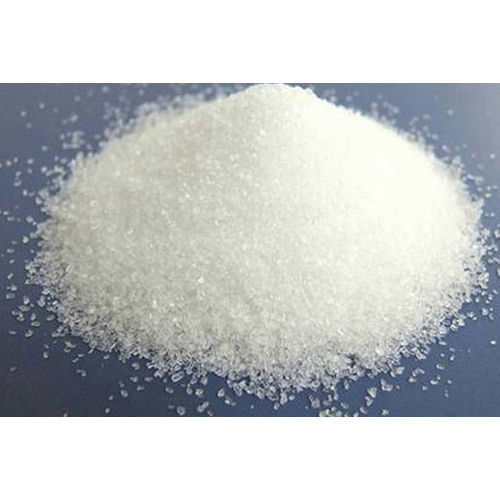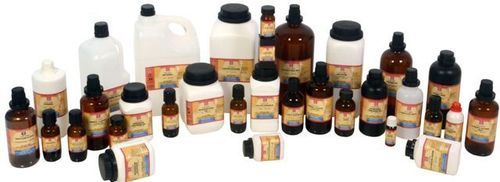लेड (II) एसीटेट ट्राइहाइड्रेट
उत्पाद विवरण:
X
उत्पाद वर्णन
LC3553 Lead(II) acetate trihydratefor analysis EMSURE ACS,Reag. Ph Eur
| Order number | Packaging | Quantity | Price |
| AC30553 | Plastic bottle | 250 g | 23.85 |
| AC30553 | Fiber carton | 1 kg | 45.90 |
| Product information | |
| Grade | ACS,Reag. Ph Eur |
| Hill Formula | C4H6O4Pb * 3 H2O |
| Chemical formula | (CH3COO)2Pb * 3 H2O |
| HS Code | 2915 29 00 |
| EC number | 206-104-4 |
| Molar mass | 379.34 g/mol |
| EC index number | 082-005-00-8 |
| CAS number | 6080-56-4 |
| Chemical and physical data | |
| Solubility | 443 g/l (20 °C) |
| Melting point | 75 °C |
| Molar mass | 379.34 g/mol |
| Density | 3.3 g/cm3 (20 °C) |
| Bulk density | 1200 kg/m3 |
| pH value | 5.5 - 6.5 (50 g/l, H2O, 20 °C) |
| Safety information according to GHS | |
| Hazard Statement(s) | H351: Suspected of causing cancer. H360FD: May damage fertility. May damage the unborn child. H373: May cause damage to organs through prolonged or repeated exposure. H410: Very toxic to aquatic life with long lasting effects. |
| Precautionary Statement(s) | P281: Use personal protective equipment as required. P273: Avoid release to the environment. P308 + P313: IF exposed or concerned: Get medical advice/attention. P314: Get medical advice/attention if you feel unwell. |
| Signal Word | Danger |
| Hazard Pictogram(s) |   |
| RTECS | OF8050000 |
| Storage class | 6.1B Non combustible substances, toxic |
| WGK | WGK 3 highly water endangering |
| Disposal | 15 Heavy metal-containing solutions and solids: container E. Stir Raney nickel (also: Urushibara nickel) in the form of an aqueous suspension into hydrochloric acid (Cat. No. 100312) until dissolved (container E). Neither Raney nickel itself nor any filter residues should be allowed to dry out, otherwise they will spontaneously ignite in air. In this context, heavy metal means any compound of antimony, arsenic, cadmium, chromium(VI), copper, lead, nickel and tin, as well as these subtances in metallic form, if they are classified as hazardous (acc. to AbfallverzeichnisV - Waste Catalogue Ordinance, Appendix 3). Other heavy metals should be collected separately. |
| Safety information | |
| R Phrase | R 61-33-48/22-50/53-62 May cause harm to the unborn child.Danger of cumulative effects.Also harmful: danger of serious damage to health by prolonged exposure if swallowed.Very toxic to aquatic organisms, may cause long-term adverse effects in the aquatic environment.Possible risk of impaired fertility. |
| S Phrase | S 53-36/37-45-61 Avoid exposure - obtain special instructions before use.Wear suitable protective clothing and gloves.In case of accident or if you feel unwell, seek medical advice immediately (show the label where possible).Avoid release to the environment. Refer to special instructions/ Safety data sheets. |
| श्रेणियाँ of danger | toxic for reproduction, harmful, dangerous for the environment |
| Hazard Symbol |  Toxic Toxic Dangerous for the environment Dangerous for the environment |
| Transport information | |
| Declaration (transport by sea) IMDG-Code | UN 1616 LEAD ACETATE, 6.1, III, Marine Pollutant: P, Segregation Group: 7 (Heavy metals and their salts (including their organometallic compounds)), 9 (Lead and its compounds) |
| Declaration (transport by air) IATA-DGR | UN 1616 LEAD ACETATE, 6.1, III |
| Toxicological data | |
| LD 50 oral | LD50 rat 4665 mg/kg |
| Specifications | |
| Assay (complexometric) | 99.5 - 102.0 % |
| Insoluble matter | ≤ 0.01 % |
| Chloride (Cl) | ≤ 0.0005 % |
| Nitrite and Nitrate (as NO3) | ≤ 0.005 % |
| Ca (Calcium) | ≤ 0.005 % |
| Cu (Copper) | ≤ 0.001 % |
| Fe (Iron) | ≤ 0.001 % |
| K (Potassium) | ≤ 0.005 % |
| Na (Sodium) | ≤ 0.005 % |
Tell us about your requirement

Price: Â
Quantity
Select Unit
- 50
- 100
- 200
- 250
- 500
- 1000+
Additional detail
मोबाइल number
Email
Laboratory Chemicals अन्य उत्पाद
हम लैब केमिकल्स में सौदे कर रहे हैं।
“केवल 500ml तक के ऑर्डर स्वीकार करने वाले रिटेल सौदे”।
“केवल 500ml तक के ऑर्डर स्वीकार करने वाले रिटेल सौदे”।
 |
ALPHA CHEMIKA
सर्वाधिकार सुरक्षित.(उपयोग की शर्तें) इन्फोकॉम नेटवर्क प्राइवेट लिमिटेड . द्वारा विकसित एवं प्रबंधित |
 English
English Spanish
Spanish French
French German
German Italian
Italian Chinese (Simplified)
Chinese (Simplified) Japanese
Japanese Korean
Korean Arabic
Arabic Portuguese
Portuguese










